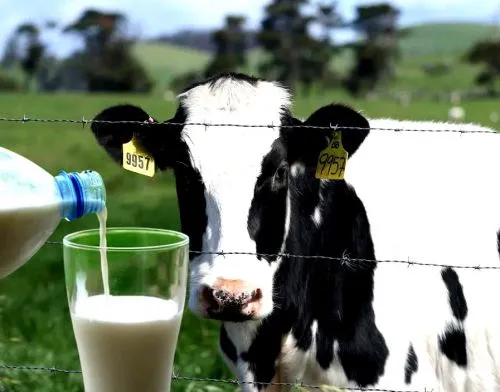The Fast News Report: Despite years of health warnings about the dangers of consuming unpasteurized products, sales of raw milk are increasing. This trend persists even in the face of a recent outbreak of bird flu affecting dairy cows.
Since the bird flu virus was first detected in U.S. cattle on March 25, weekly sales of raw cow’s milk have surged, increasing by 21% to as much as 65% compared to the same time frames last year, according to market research firm NielsenIQ.
This trend contradicts recommendations from the Food and Drug Administration and the Centers for Disease Control and Prevention, both of which classify raw milk as on
CDC’s website
Federal officials reported that, as of Monday, cows infected with the type A H5N1 virus were in at least 42 herds across nine states.e of the most hazardous foods available. According to the CDC’s website, “Raw milk can be contaminated with harmful germs that can make you very sick.”
The virus has been detected in significant quantities in the raw cows milk of infected cows. Although traces of the virus have been found in milk samples from grocery stores, the
FDA assures that these products are safe to consume because the pasteurization process effectively eliminates the virus.
It remains uncertain whether the live virus can be transmitted to individuals who consume milk that has not undergone heat treatment.
However, CDC officials cautioned last week that individuals who cows drink raw milk could theoretically become infected if the bird flu virus contacts receptors in the nose, mouth, and throat or if it is inhaled into the lungs. Additionally, there is concern that increased exposure to the virus could lead to mutations, making it more easily transmissible among humans.
Regulations on raw milk vary significantly across states. Some states permit retail sales in stores, while others restrict sales to farms only. Certain states allow “cowshares,” where individuals pay to receive cows milk from specific cows. In contrast, other states limit raw milk consumption to farm owners, employees, or “non-paying guests” only.
Readmore Stock Market Today Report: latest winning week Dow finishes above 40,000
Grocery Stores
The NielsenIQ data, which encompass grocery stores and other retail venues, indicate that raw milk products represent a minor portion of total dairy sales. For example, during the week of May 5, approximately 4,100 units of raw cow’s milk and 43,000 units of raw milk cheese were sold.
In contrast, about 66.5 million units of pasteurized cow’s milk and 62 million units of pasteurized cheese were sold during the same period.
Despite this, endorsements for raw milk are becoming increasingly popular on social media platforms. Mark McAfee, the owner of Raw cows Farm USA in Fresno, California, reports that he cannot keep up with the demand for his unpasteurized products.
People are actively seeking out raw milk,” he said, highlighting that neither bird flu nor any related issues have been detected in his herds or California. “Our customers often go against the recommendations provided by the FDA
Food Safety
The surge in raw milk sales surprised Donald Schaffner, a food science professor at Rutgers University. He characterized the trend as “absolutely stunning.” “Food safety experts like myself are just left shaking our heads,” he commented.
Between 1998 and 2018, the CDC recorded over 200 illness outbreaks associated with raw milk, affecting over 2,600 individuals and resulting in more than 225 hospitalizations.
Research indicates that raw milk is significantly more likely than pasteurized milk to cause illnesses and hospitalizations due to harmful bacteria such as campylobacter, listeria, salmonella, and E. coli.
Dairy Research Center
According to Alex O’Brien, safety and quality coordinator for the Center for Dairy Research, before milk standards were established in 1924, approximately 25% of foodborne illnesses in the U.S. were linked to dairy consumption. Now, dairy products contribute to only about 1% of such diseases.
O’Brien compared consuming raw milk to playing Russian roulette. He emphasized that the more frequently individuals consume it, the higher the likelihood of falling ill.
Despite these risks, a 2022 FDA study revealed that approximately 4.4% of U.S. adults, nearly 11 million people, report drinking raw milk at least once per year. Additionally, about 1% admit to consuming it on a weekly basis.
Drinking Raw Milk
Bonni Gilley, 75, from Fresno, shared that she has been providing her family with raw milk, unpasteurized cream, and butter for generations because she believes they are healthier options without additives. Despite the reports of bird flu in dairy cattle, Gilley stated that it has not caused her to reconsider drinking raw milk.
“If anything, it is reinforcing my belief in raw milk,” she remarked, citing her lack of trust in government officials as a contributing factor.
Matthew Motta, an expert in health misinformation at Boston University, noted that these sentiments reflect a broader issue of distrust in government and dismissal of expertise.
It’s not a matter of people being unintelligent or uninformed about the science,” he explained. “Rather, their rejection of it often stems from partisanship, political ideology, religion, or cultural values.”
Officials from the CDC and FDA declined to comment on the growing popularity of raw milk.
Motta proposed that the agencies should counter this trend by sharing social media content highlighting the health benefits of pasteurized milk.
“Communicators should strive to comprehend the reasons behind people’s preference for raw milk and engage with them on those grounds,” he suggested.










